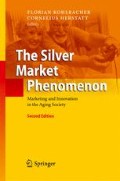Abstract
Products that surround us have a profound impact upon our lives. When they empower us to complete daily tasks with ease, speed, and dignity they contribute to our well-being and independence. When they generate negative experiences, they can strip us of dignity and erode our independence. Many companies confuse age with ability, which can diminish the value of the final product. This chapter discusses two techniques that address ability by adding empathy to the design process. Real People targets specific individuals. Empathic Modeling simulates physical challenges that designers can experience for themselves.
Access this chapter
Tax calculation will be finalised at checkout
Purchases are for personal use only
Notes
- 1.
There are earlier examples of interest in the topic. For instance, designer Henry Dreyfuss’ 1955 Designing for People and 1960 Measure of Man compiled government databases on anthropometric sizes of men and women for use in product design.
- 2.
OXO’s Good Grips line of kitchen tools were designed by Smart Design to address the needs of everyone, including people with arthritis. They have become closely associated with the concept of Universal Design, design for everyone.
References
L.H. Campbell, D. McDonagh, Visual narrative research methods as performance in industrial design education. Qual. Inq. 15, 587–606 (2009)
J. Chapman, Emotionally Durable Design: Objects, Experiences and Empathy (Earthscan, London, 2005)
D. Formosa, The six real people. Paper presented in the proceedings of the international association of societies of design research, Coex, Seoul, Korea. Korean Society of Design Science [CDROM], Kyunggi-do, 2009
W. Lidwell, K. Holden, J. Butler, Universal Principles of Design: 115 Ways to Enhance Usability, Influence Perception, Increase Appeal, Make Better Design Decisions, and Teach Through Design (Rockport, Beverly, MA, 2010)
J. Fulton Suri, Empathic Design: Informed and Inspired by Other People’s Experience, in Empathic Design: User Experience in Product Design, ed. by I. Koskinen, K. Battarbee, T. Mattelmäki (IT, Finland, 2003)
D. McDonagh, Do it until it hurts! Empathic design research. Des. Princ. Pract. 2(3), 103–109 (2008)
N. Hansen, C. Philo, The normality of doing things differently: Bodies, spaces and disability geography. Tijdschrift voor Economische en Sociale Geografie 98(4), 493–506 (2007)
D. Formosa, D. McDonagh, I wasn’t that comfortable anyway (in design-system-evolution). Paper presented in the proceedings of the 6th international conference of the European academy of design, EAD06, Bremen, Germany, 29–31 Mar 2005
D. McDonagh, J. Thomas, S. Chen, J. He, Y.S. Hong, Y. Kim, Z. Zhang, F. Pena-Mora, Empathic Design Research: Disability + Relevant Research. Design Connexity. Paper presented in the 8th European academy of design international conference, The Robert Gordon University, Aberdeen, Scotland, 1–3 April 2009, pp. 310–315
M.L. Khuri, Working in emotion in educational interwork dialogue. Int. J. Intercult. Relat. 28, 595–612 (2004)
H. Denton, D. McDonagh, Using focus groups to support the designer in the evaluation of existing products: A case study. Des. J. 2(2), 20–31 (1999)
B. Laurel (ed.), Design Research: Methods and Perspectives (Massachusetts Institute of Technology, London, 2003)
J. Clarkson, R. Coleman, S. Keates, C. Lebbon, Inclusive Design: Design for the Whole Population (Springer, London, 2003)
Author information
Authors and Affiliations
Editor information
Editors and Affiliations
Rights and permissions
Copyright information
© 2011 Springer-Verlag Berlin Heidelberg
About this chapter
Cite this chapter
McDonagh, D., Formosa, D. (2011). Designing for Everyone, One Person at a Time. In: Kohlbacher, F., Herstatt, C. (eds) The Silver Market Phenomenon. Springer, Berlin, Heidelberg. https://doi.org/10.1007/978-3-642-14338-0_7
Download citation
DOI: https://doi.org/10.1007/978-3-642-14338-0_7
Published:
Publisher Name: Springer, Berlin, Heidelberg
Print ISBN: 978-3-642-14337-3
Online ISBN: 978-3-642-14338-0
eBook Packages: Business and EconomicsBusiness and Management (R0)

